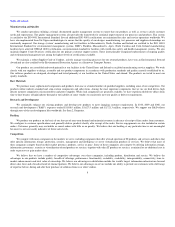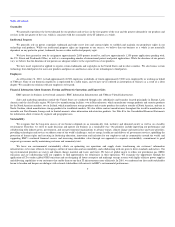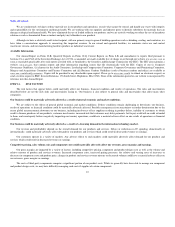EMC 2010 Annual Report Download - page 19
Download and view the complete annual report
Please find page 19 of the 2010 EMC annual report below. You can navigate through the pages in the report by either clicking on the pages listed below, or by using the keyword search tool below to find specific information within the annual report.
Table of Contents
In addition to the risks commonly encountered in the acquisition of a business as described above, we may also experience risks relating to the
challenges and costs of closing a transaction. Further, the risks described above may be exacerbated as a result of managing multiple acquisitions at the same
time.
We also seek to invest in businesses that offer complementary products, services or technologies. These investments are accompanied by risks similar
to those encountered in an acquisition of a business.
Our pension plan assets are subject to market volatility.
We have a noncontributory defined benefit pension plan assumed as part of our Data General acquisition. The plan's assets are invested in common
stocks, bonds and cash. The expected long-term rate of return on the plan's assets is 6.75%. This rate represents the average of the expected long-term rates of
return weighted by the plan's assets as of December 31, 2010. We have begun to shift, and may continue to shift in the future, its asset allocation to lower the
percentage of investment in equity securities and increase the percentage of investments in fixed-income securities. The effect of such change could result in a
reduction in the long-term rate on plan assets and an increase in future pension expense. As of December 31, 2010, the ten-year historical rate of return on
plan assets was 4.1%, and the inception to date return on plan assets was 9.8%. In 2010, we experienced a 12.6% gain on plan assets. Should we not achieve
the expected rate of return on the plan's assets or if the plan experiences a decline in the fair value of its assets, we may be required to contribute assets to the
plan which could materially adversely affect our results of operations or financial condition.
Our business could be materially adversely affected by changes in regulations or standards regarding energy use of our products.
We continually seek ways to increase the energy efficiency of our products. Recent analyses have estimated the amount of global carbon emissions that
are due to information technology products. As a result, governmental and non-governmental organizations have turned their attention to development of
regulations and standards to drive technological improvements and reduce such amount of carbon emissions. There is a risk that the development of these
standards will not fully address the complexity of the technology developed by the IT industry or will favor certain technological approaches. Depending on
the regulations or standards that are ultimately adopted, compliance could adversely affect our business, results of operations or financial condition.
Our business could be materially adversely affected as a result of war, acts of terrorism or natural disasters.
Terrorist acts, acts of war, natural disasters or other indirect effects of climate change may cause damage or disruption to our employees, facilities,
customers, partners, suppliers, distributors and resellers, which could have a material adverse effect on our business, results of operations or financial
condition. Such events may also cause damage or disruption to transportation and communication systems and to our ability to manage logistics in such an
environment, including receipt of components and distribution of products.
ITEM 1B. UNRESOLVED STAFF COMMENTS
None.
18
























